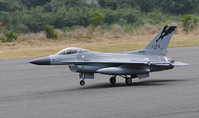Mike Benefield
EF1
I'm not sure if this is the appropriate place to post this, but I'll give it a try. I'm into avionics and aerodynamics especially when it comes to model aircraft. I'm going to purchase a kit for a radio-controlled jet that I will use in an attempt to obtain tornado data. The jet has a top speed of up to 220 mph. It has enough thrust that it can fly straight up. I'm not sure how well the jet will perform in rough conditions. I don't even know if it's possible with the rapidly changing tailwinds, headwinds, downdrafts, and vertical ascent in and around the periphery of a tornado. If I can find a tornado, I will orbit it (not too close!) and collect data, dropping probes at key locations, particularly in the inflow. It will have an on-board barometer, GPS, ELT, a pan-tilt camera with a full 360 degree view, controls for retractable landing gear, flaps, throttle, ailerons, rudder, and elevator. I will use a 14-channel radio with a built-in video screen. The camera will be used for flying as if you were in the plane (also known as FPV - First Person View). A high-gain directional antenna will substanially increase the range by up to five miles. I'm fully aware that this is a monumental undertaking, and it will be very expensive.
So, what do you think? I need input from members. Please share your ideas.
This F-16 is the one I want. It's highly maneuverable with plenty of space inside for electronics. It is 10 feet long with a 6.5 foot wingspan.

So, what do you think? I need input from members. Please share your ideas.
This F-16 is the one I want. It's highly maneuverable with plenty of space inside for electronics. It is 10 feet long with a 6.5 foot wingspan.

